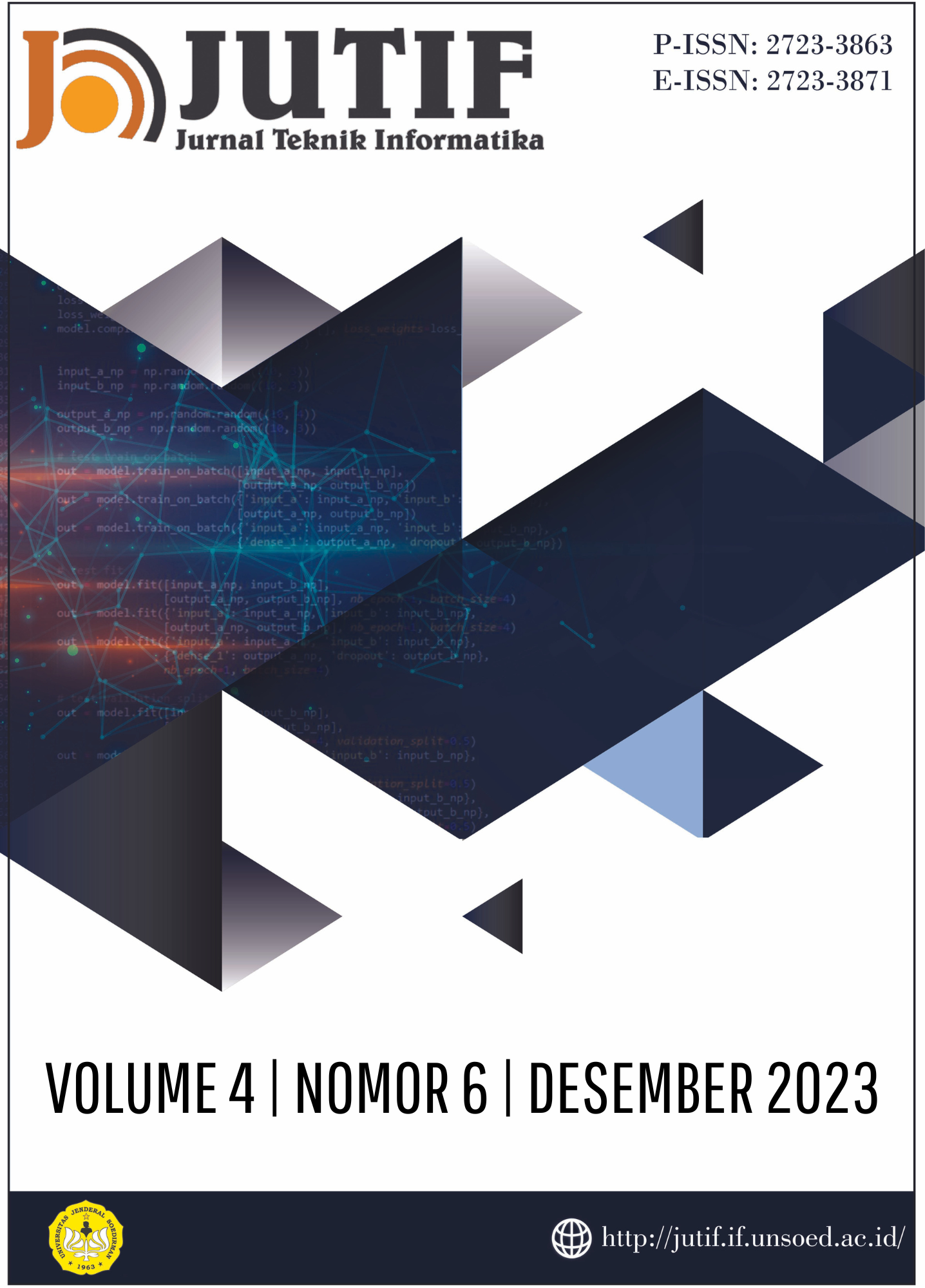COMPARISON OF NAIVE BAYES, DECISION TREE, AND RANDOM FOREST ALGORITHMS IN CLASSIFYING LEARNING STYLES OF UNIVERSITAS KRISTEN INDONESIA TORAJA STUDENTS
Abstract
Learning style is an individual's habit or way of absorbing, processing, and managing information. This factor is very important in achieving learning goals. However, in reality, learning styles are often overlooked in the learning process, which can lead to suboptimal absorption of lessons and affect the quality of education. Various models have been developed by educational experts to identify students' learning styles, one of which is the VAK model (Visualization Auditory Kinesthetic) for grouping learning styles. This study compares algorithms in classifying learning styles using the VAK model. The results showed that the most dominant learning style was kinesthetic with a percentage of 46.9% or 478 students. The algorithm modeling showed that Naive Bayes had the highest accuracy with a value of 75%, while Random Forest had the lowest accuracy with a value of 59%. This suggests that Naive Bayes is more suitable for classifying students' learning styles. In conclusion, understanding students' learning styles is crucial for effective education. The VAK model is one way to identify learning styles, and Naive Bayes is a suitable algorithm for classifying students' learning styles. By considering learning styles, educators can tailor their teaching methods to better suit their students' needs and improve the quality of education.
Downloads
References
Y. Wahyuni, “Identifikasi Gaya Belajar (Visual, Auditorial, Kinestetik) Mahasiswa Pendidikan Matematika Universitas Bung Hatta,” J. Penelit. dan Pembelajaran Mat., vol. 10, no. 2, pp. 128–132, 2017, doi: 10.30870/jppm.v10i2.2037.
T. F. Prasetyo and M. Iqbal, “Sistem Pakar Identifikasi Gaya Belajar Mahasiswa Berbasis Web,” Semin. Nas. Sains dan Teknol. 2016 Fak. Tek. Univ. Muhammadiyah Jakarta, no. November, pp. 1–7, 2016, [Online]. Available: https://jurnal.umj.ac.id/index.php/semnastek/article/view/776.
F. D. Widayanti, “Pentingnya Mengetahui Gaya Belajar Siswa Dalam Kegiatan Pembelajaran Di Kelas,” Erud. J. Educ. Innov., vol. 2, no. 1, 2013, doi: 10.18551/erudio.2-1.2.
R. K. Dewi, W. Sunarno, and S. Budiawanti, “Pengaruh Model Somatic Auditory Visualization Intellectualy (SAVI) dan Visualization Auditory Kinesthetic (VAK) dengan Pendekatan Ilmiah Terhadap Hasil Belajar Fisika Siswa SMA Ditinjau dari Gaya Belajar,” J. Mater. dan Pembelajaran Fis., vol. 11, no. 2, p. 75, 2021, doi: 10.20961/jmpf.v11i2.49008.
E. N. Fitri et al., “DECISION TREE SIMPLIFICATION THROUGH FEATURE SELECTION,” J. Tek. Inf., vol. 4, no. 2, 2023.
Y. Mardi, “Data Mining : Klasifikasi Menggunakan Algoritma C4.5,” Edik Inform., vol. 2, no. 2, pp. 213–219, 2017, doi: 10.22202/ei.2016.v2i2.1465.
F. S. Pamungkas, B. D. Prasetya, and I. Kharisudin, “Perbandingan Metode Klasifikasi Supervised Learning pada Data Bank Customers Menggunakan Python,” Prism. Pros. Semin. Nas. Mat., vol. 3, pp. 692–697, 2020, [Online]. Available: https://journal.unnes.ac.id/sju/index.php/prisma/article/view/37875.
U. Islam, N. Sunan, G. Djati, and M. F. Rachman, “Implementasi_Metode_Decision_Tree_Untuk,” J. Inform., vol. 10, no. 1, 2020.
W. Yustanti and N. Rochmawati, “Analisis Algoritma Klasifikasi untuk Memprediksi Karakteristik Mahasiswa pada Pembelajaran Daring,” JEPIN (Jurnal Edukasi dan Penelit. Inform., vol. 8, no. 1, pp. 57–61, 2022.
Oscario, Jasmir, And Yudi, “Penerapan Algoritma C4.5 Untuk Memprediksi Kecocokan Gaya Belajar Bagi Siswa Siswi Sekolah Dasar (Studi Kasus : Sd Sariputra Algoritma C4.5 Untuk Memprediksi Kecocokan Gaya Belajar Bagi Siswa Siswi Sekolah Dasar (Studi Kasus : SD Sariputra Jambi),” J. Process., vol. 14, no. 2, pp. 141–152, 2019, doi: 10.33998/processor.2019.14.2.637.
M. I. P. Hant and H. Hendry, “Data Mining Technique Using Naïve Bayes Algorithm To Predict Shopee Consumer Satisfaction Among Millennial Generation,” J. Tek. Inform., vol. 3, no. 4, pp. 829–838, 2022, doi: 10.20884/1.jutif.2022.3.4.295.
Robianto ; Sampe Hotlan Sitorus ; Uray Ristian, “Penerapan Metode Decision Tree Untuk Mengklasifikasikan Mutu Buah Jeruk BerdasarkanFitur Warna Dan Ukuran,” J. Komput. dan Apl., vol. 9, no. 01, pp. 76–86, 2021.
R. Supriyadi, W. Gata, N. Maulidah, and A. Fauzi, “Penerapan Algoritma Random Forest Untuk Menentukan Kualitas Anggur Merah,” E-Bisnis J. Ilm. Ekon. dan Bisnis, vol. 13, no. 2, pp. 67–75, 2020, doi: 10.51903/e-bisnis.v13i2.247.
D. Y. Kardono, Y. M. Pranoto, and E. Setyati, “Prediksi Kecocokan Jurusan Siswa SMK Dengan Support Vector Machine dan Random Forest,” Teknika, vol. 12, no. 1, pp. 11–17, 2023, doi: 10.34148/teknika.v12i1.567.
N. Agustina, A. Adrian, and M. Hermawati, “Implementasi Algoritma Naïve Bayes Classifier untuk Mendeteksi Berita Palsu pada Sosial Media,” Fakt. Exacta, vol. 14, no. 4, pp. 1979–276, 2021, doi: 10.30998/faktorexacta.v14i4.11259.
Gde Agung Brahmana Suryanegara, Adiwijaya, and Mahendra Dwifebri Purbolaksono, “Peningkatan Hasil Klasifikasi pada Algoritma Random Forest untuk Deteksi Pasien Penderita Diabetes Menggunakan Metode Normalisasi,” J. RESTI (Rekayasa Sist. dan Teknol. Informasi), vol. 5, no. 1, pp. 114–122, 2021, doi: 10.29207/resti.v5i1.2880.
S. Ramadandi and J. Jahring, “Student Learning Style Classification Using Naïve Bayes Classifier Method,” J. Teknol. dan Inf., vol. 10, no. 2, pp. 170–179, 2020, doi: 10.34010/jati.v10i2.3096.
D. N. Sari, H. Oktavianto, and I. Saifudin3, “Penerapan Data Mining Untuk Klasifikasi Gaya Belajar Siswa Menggunakan Algoritma C4.5 Application,” J. Smart Teknol., vol. 3, no. 2, pp. 184–190, 2022.
Copyright (c) 2023 Melki Garonga, Rita Tanduk

This work is licensed under a Creative Commons Attribution 4.0 International License.




























